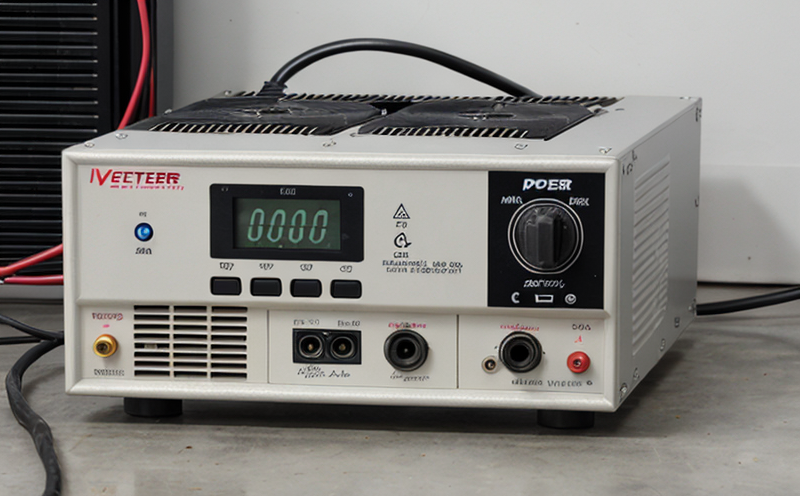ASTM E2233 Efficiency Measurement Testing of Power Electronics
The ASTM E2233 standard provides a method for determining the efficiency of photovoltaic (PV) inverters and other power electronics systems used in renewable energy applications. This test is crucial for ensuring that these devices operate at optimal levels, thereby maximizing their performance and minimizing energy losses. The testing process involves measuring the input and output power to determine the efficiency, which is calculated as a percentage.
The ASTM E2233 standard ensures consistency across different laboratories by providing specific guidelines on how to perform this test accurately. This standard applies particularly in sectors like solar energy, wind energy, and other renewable energy systems where inverters play a vital role in converting DC power from renewable sources into AC for use in homes and businesses.
The ASTM E2233 efficiency measurement testing is not just about compliance; it's also about performance. By ensuring that the devices meet or exceed the specified efficiency levels, manufacturers can improve their products' reliability and reduce operational costs. This test helps in identifying any inefficiencies early on so that corrective actions can be taken to enhance product quality.
In summary, ASTM E2233 is essential for industries reliant on renewable energy technologies. It ensures consistent testing methodologies across various laboratories worldwide, thereby promoting accurate and reliable data. The standard also plays a critical role in improving the overall efficiency of power electronics systems used in these sectors.
| Applied Standards | Description |
|---|---|
| ASTM E2233 | Determination of Efficiency of Photovoltaic Inverters and Other Power Electronics Systems Using the Method of ASTM E2233. |
Why It Matters
The importance of ASTM E2233 efficiency measurement testing cannot be overstated, especially in sectors like energy and renewable energy. Inverters are critical components that convert DC power from solar panels or wind turbines into AC suitable for household use. Ensuring their efficient operation is paramount to the success of any renewable energy project.
Efficient inverters not only reduce operational costs but also contribute significantly to environmental sustainability by minimizing energy losses during conversion processes. By adhering to ASTM E2233, manufacturers can guarantee that their products meet international standards, enhancing trust among consumers and regulators alike.
Moreover, accurate efficiency measurements help in identifying potential issues early on, allowing for timely interventions. This proactive approach ensures prolonged product life and enhances overall system reliability, which is crucial given the high investment costs associated with renewable energy installations.
In essence, ASTM E2233 efficiency measurement testing is not just a compliance requirement; it's an essential tool for maintaining optimal performance across various applications in the energy sector. It contributes to both economic benefits and environmental conservation efforts.
Applied Standards
| Applied Standards | Description |
|---|---|
| ASTM E2233 | Determination of Efficiency of Photovoltaic Inverters and Other Power Electronics Systems Using the Method of ASTM E2233. |
| IEC 61850 | Communication Networks and Systems for Substations, Particular Requirements for Protective Relaying Devices. |
The application of these standards ensures that the testing procedures are consistent and reliable, leading to accurate results. Compliance with ASTM E2233 is particularly important because it provides a standardized approach to measuring efficiency, which is critical for ensuring product quality and performance.
Furthermore, adherence to such international standards demonstrates commitment to best practices within the industry, fostering greater confidence among stakeholders. By adopting these standards, laboratories can offer services that are recognized globally, enhancing their reputation and credibility in the market.
Why Choose This Test
Selecting ASTM E2233 efficiency measurement testing for your power electronics is a strategic decision that offers numerous benefits. Firstly, it provides you with comprehensive insights into the performance of your inverters or other power electronics systems. By measuring both input and output power accurately, you can identify any inefficiencies early on, allowing for timely corrections.
Secondly, this testing method helps in optimizing energy conversion processes, leading to significant cost savings over time. With continuous improvements in efficiency, there are fewer energy losses during the conversion process, resulting in lower operational costs. This translates directly into financial benefits for businesses operating in renewable energy sectors.
In addition, compliance with ASTM E2233 ensures that your products meet international standards, enhancing their marketability and acceptance across different regions. As more countries adopt stringent regulations regarding renewable energy usage, having a tested product aligned with these norms can give you a competitive edge in the global market.
Lastly, this testing method supports sustainable development goals by promoting efficient use of resources. By ensuring that your inverters or power electronics systems operate at peak efficiency, you contribute positively to environmental conservation efforts. This aligns perfectly with broader sustainability initiatives aimed at reducing carbon footprints and conserving natural resources.





